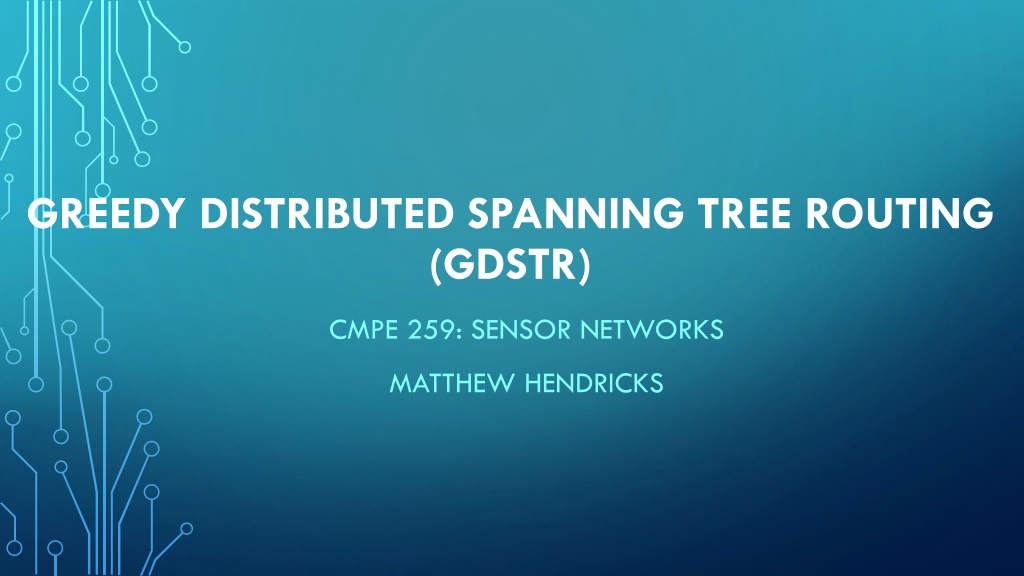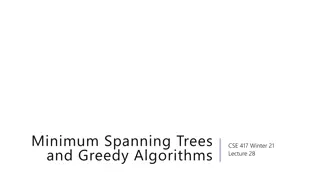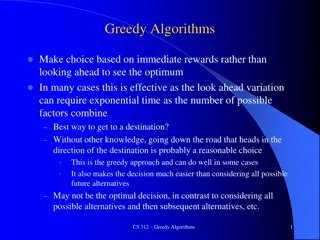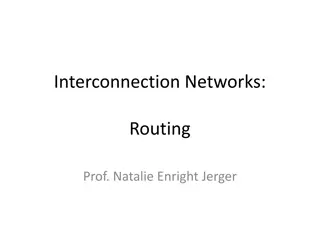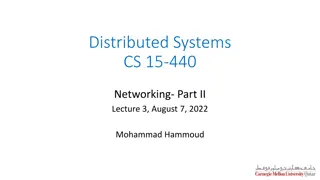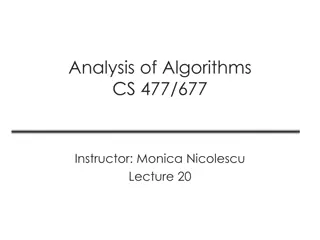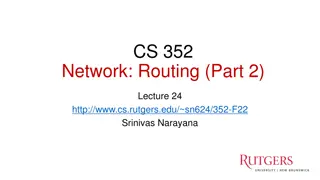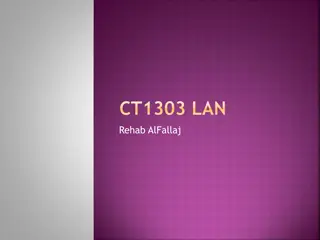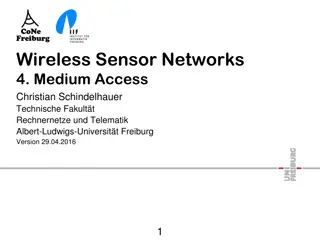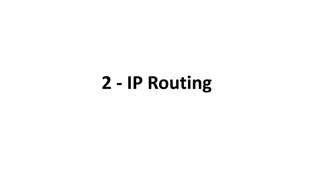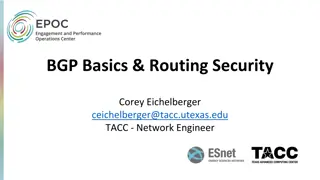Understanding Greedy Distributed Spanning Tree Routing in Wireless Sensor Networks
Wireless sensor networks play a critical role in various applications, and the Greedy Distributed Spanning Tree Routing (GDSTR) protocol, developed by Matthew Hendricks, offers an efficient routing approach. This protocol addresses challenges such as scalability, dynamic topologies, and sensor node issues by utilizing a distributed tree structure based on greedy forwarding. GDSTR leverages location awareness, convex hull trees, and face routing methods to enhance routing efficiency in sensor networks.
Download Presentation

Please find below an Image/Link to download the presentation.
The content on the website is provided AS IS for your information and personal use only. It may not be sold, licensed, or shared on other websites without obtaining consent from the author. Download presentation by click this link. If you encounter any issues during the download, it is possible that the publisher has removed the file from their server.
E N D
Presentation Transcript
GREEDY DISTRIBUTED SPANNING TREE ROUTING (GDSTR) CMPE 259: SENSOR NETWORKS MATTHEW HENDRICKS
WIRELESS SENSOR NETWORKS Requirements: Made up of several nodes/sensors Nodes consist of a CPU, storage, transmitter, and battery Communications sometimes take many hops to reach the sink
SCALABILITY OF SENSOR NETWORKS Limited recourses lead design Battery powered Less storage Scalability and Robustness Must accommodate additional nodes Has to work though node failure
MICA 2 "MOTE" Price (about $150) Sensor expantion board ($120) - light - temperature - microphone More sofisticated boards available - accelerometers - GPS
DYNAMIC TOPOLOGIES Node issues Nodes are subject to physical harm Hardware issues Battery failure Transmission issues Physical obstacles RF interference
THE APPROACH OF GDSTR Route via location Nodes are aware of their location GPS Static location Indoor networks Packet destination field = the destination location
PREREQUISITES OF GDTSR Node placement occur on a plane Radio Links are Bi-Directional Transmission power is uniform
GEOGRAPHIC ROUTING Greedy forwarding: Uses local information to route Hop closest to destination is chosen
ISSUES Dead ends Closest neighbor to destination not always available Face routing remedy used in other protocols
FACE ROUTING Route messages through planar graph Does not scale well
HULL TREES Each node has a "convex hull" Convex hulls contain all descendant nodes within Storage is O(1) vs. O(N)
ROUTING WITH HULL TREES If destination is not within convex hull, forward to the parent If destination is in the convex hull, forward packet
ROUTING WITH HULL TREES CONTINUED... If the packet was in greedy mode previously or was sent from the parent node: Packet will be forwarded to first child node containing destination. If the packet came from a child node: Packet will be forwarded to the next child node that's convex has the destination within it If the packet came from child node from hulls that have destination within: Packet will go to the parent or child node that is also root node.
PERFORMANCE ISSUES Routing via decisions based on trees is slower GDSTR only uses trees when needed GDSTR switches back to greedy routing as soon as possible Tree hops are used as little as possible
CREATION OF HULL TREES Routing performance gains from less overlap between convex hulls Compact trees are ideal and lead to less hop count Smaller trees broadcast chosen parent node and convex hull
ROUTING ALGORITHM Mode: current greedy or tree routing style N min: node where packet switches from greedy to tree routing Tree: identifier for the root of hull tree N anchor: first discovered node while traversing tree
ALGORITHM (GDSTR) 1. Check for Greedy mode switch 2. Greedy Mode 3. Tree Mode 4. Choose Hull Tree 5. Check Hull Tree 6. Not in Hull Tree 7. Check Anchor Node 8. Termination Condition 9. Tree Traversal
1. CHECKING FOR MODE "If p.mode = Tree and there is at least one immediate neighbor w such that |wt| < |(p.nmin)t|, then set p.mode := Greedy, p.nmin := w and clear p.nanchor and p.tree if they are set. Execute step 2 or 3 according to p.mode"
2. GREEDY MODE Find the node w in the set of immediate neighbors that is closest to t. If |wt| < |vt|, forward the packet to w. Otherwise, set p.mode := Tree and follow step 3.
3. TREE MODE If p.tree is not set or if the root for p.tree has changed, follow step 4, else follow step 5.
4. CHOOSE HULL TREE Choose one of the existing hull trees for forwarding and set p.tree to the chosen tree s identifier. Follow step 5.
5. CHECK HULL TREE If hull tree does not contain destination node t, follow step 6; otherwise, follow step 7 instead.
6. NOT IN HULL TREE If none of the hulls in H contains the destination node t conclude that the packet is not deliverable. Otherwise, forward p to the parent node in p.tree.
7. CHECK ANCHOR NODE If p.nanchor is set, follow step 8. Else, set p.nanchor := v and follow step 9 instead.
8. TERMINATION CONDITION Given a global ordering for node identifiers, arrange the child nodes (relative to p.tree) with convex hulls that contain the destination point in a ascending sequence according to the global ordering. Then: 5 If v = p.anchor and either (i) u is the last child and v is the root node for p.tree, (ii) u is the last child and the set of conflict hulls H does not contain destination node t, or (iii) u is the parent node, conclude that packet is not deliverable; else If u is the parent node and the set of conflict hulls H does not contain destination node t, set p.nanchor := v. Follow step 9. "
9. TREE TRAVERSAL If p.mode = Greedy set p.mode := Tree, forward packet to the first child node; If packet was received from the parent node forward packet to the first child node; If packet was received from a child node forward packet to the next child node in the sequence; If packet was received from the last child node if one of the hulls in H contains the destination point; forward packet to the parent node Else forward packet to the first child node.
SIMULATION Unit radio range Communication if and only if within range, and have line of site Wireless issues not accounted for Networks of 25 to 500 nodes Randomly place in 10 x 10 unit square 200 networks tested 20,000 packets routed Source and destination randomly selected
SIMULATION COMPARISONS Greedy Perimeter Stateless Routing (GPSR) Greedy Other Adaptive Face Routing Plus (GOAFR+) Greedy Path Vector Face Routing (GPVFR) Cross-Link Detection Protocol (CLDP) planarization A density of 500 nodes in 100 square units is high enough that greedy forwarding almost always succeeds
ROUTING RESULTS Path stretch: Ratio of path length between nodes Hop stretch: ratio of hops between two nodes against the number of hops on the shortest path Metrics were considered similar enough to be plotted together
ROUTING RESULTS From node degree range 2 to 9 GDSTR outperforms other algorithms Most improvement in the node degree range 4 to 6 GDSTR routes where often shorter Faster delivery Less consumption of radio resources
BANDWIDTH RESULTS GDSTR broadcast (keep alive) vs. CLDP probes Broadcast messaging smaller on average up till a node degree of 4 to 8 Probes contain all point faces 4 to 8 range had largest perimeters
BANDWIDTH RESULTS CLDP probes are sent out until all links are considered dormant or non-routable GDSTR converges when hull information stabalizes
SCALABILITY RESULTS CLDP message count independent of node count GDSTR fail messaging increases gradually with node count GDSTR join messaging independent of node count
CONCLUSIONS Hull trees can be at least as efficient as planar graphs after greedy forwarding GDSTR uses less maintenance bandwidth than CLDP Testing was conducted on stationary two dimensional graphs, but could adapt to mobile multidimensional situation
